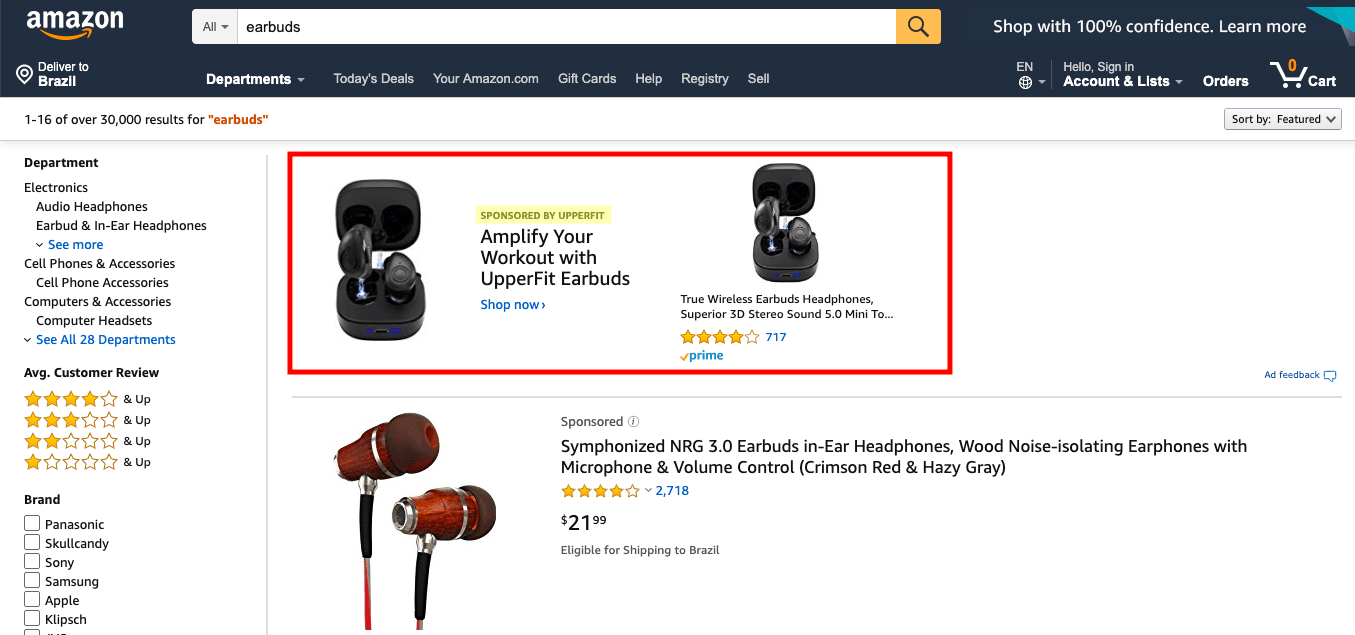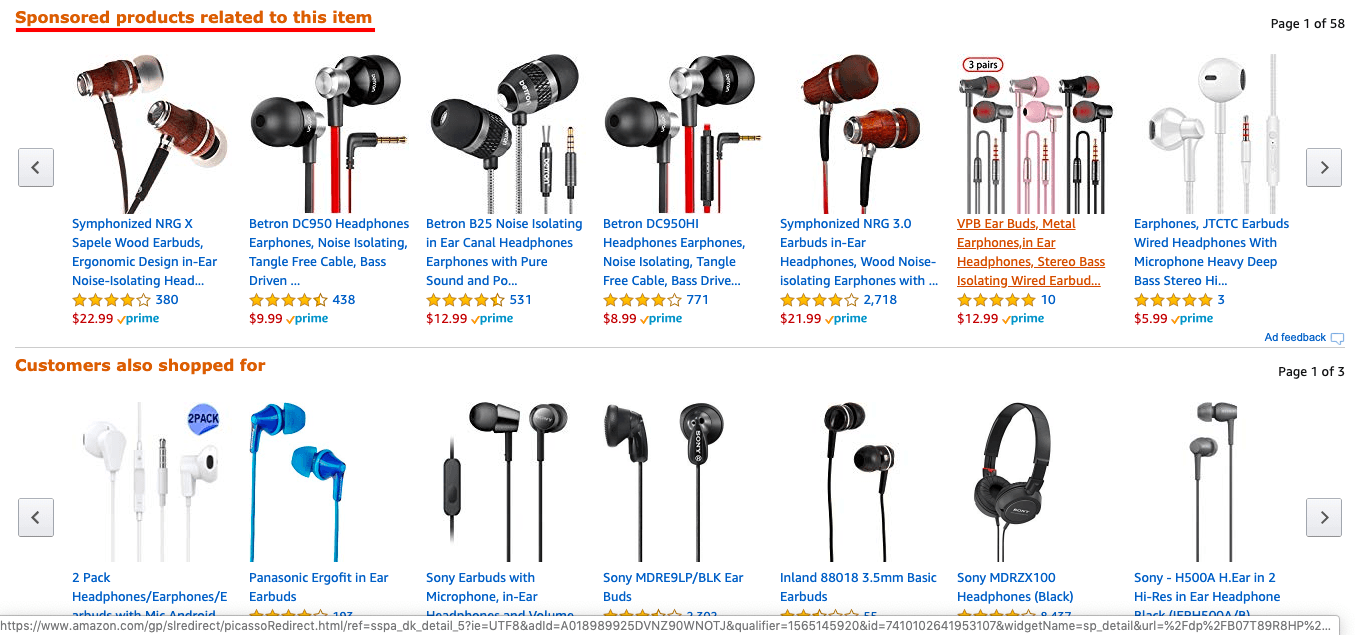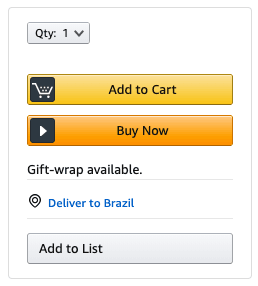As an Amazon seller, your primary goal is most likely a boost in your sales. And using Amazon Sponsored Products might be the key to accomplish that. Amazon Sponsored Products are like Google Ads, but for Amazon products.
With an exponential growth in the availability and variety of products within the Amazon Marketplace, mastering the Sponsored Products platform might be the great differential to bypass your competitors. You may have already been influenced by one of these sponsored ads yourself, as a customer, without even noticing it.
Amazon Sponsored Products: How do they work?
There are three ways that a Sponsored Product can appear:
Search Page: in the top of the results. Sometimes it can be found in the right sidebar too.
Product Page: in the page of a chosen product, there’s always a topic called “Sponsored products related to this item”.
The Buy Box: In order to be applicable for the Amazon Sponsored Ads, it’s important that the seller has ownership of the “buy box”. The buy box is simply the box located on the right side of the product page, which allows the buyer to add the item to their cart.
Obtaining the Buy Box is usually related to having a clean record at Amazon — a good selling history, positive customers reviews, well-managed fulfillment and stock availability.
Amazon Search Data
One of the best reasons to use Amazon Sponsored Products is to gain access to the data provided by them. Similar to other ad platforms like Google, Facebook and Twitter, Amazon provides you business insights when you pay for promoted ads.
Getting your hands on the spreadsheet that they will provide you, can greatly improve your campaigns, by allowing you to know the keywords that give you the best results.
The file is nothing but a raw .csv that informs you of the words used in your titles and descriptions, and the customer search terms that relate to them. As you continue to read this article, you’ll understand the importance of those customer search terms.
Starting with the basics: what you should know before starting an ad campaign
Before jumping into your first Amazon Sponsored Products Ad, there are a few things you should keep in mind. These definitions will be essential when setting up and managing your first campaign.
Pay-Per-Click
Amazon Sponsored Products pricing works according to the Pay Per Click model. This means that your ad won’t be charged per impressions (when it gets displayed to a potential customer). Instead, its price is going to be calculated as per the amount of clicks it gets.
Conversion Rate
This indicator measures how many clicks on your ad were converted into an actual sale. The success of this rate will indicate the effectiveness of your campaign.
Advertising Cost of Sales (ACoS)
This indicates the percentage rate of your advertising cost versus your advertising revenue. This shows how profitable your campaign is. But what is a good percentage?
The lowest the ACoS, the better (usually). There are a few metrics to consider here:
- High ACoS: is over 40%. This outcome might happen when a keyword is gaining a lot of traffic but has a low conversion rate.
- Average ACoS: is between 25% and 40%.
- Low ACoS: is under 25%.
Organizing Your Ads
Before jumping into your first ad, you might want to take a moment to plan what ad groups are ideal to represent to your business. You can create a campaign for each product or for each type of product. What we recommend to you though is to create a campaign for each of your SKUs.
This way, you’ll be able to track the metrics by SKU and analyze results like seasonality or different outcomes for different strategies.
How to Set Up Your Campaign
It’s time to get started with your first campaign. In the Campaign Manager page, click on Sponsored Products and find the Create Campaign button. You then set the name, cost and duration of your campaign, and the type of target.
Choosing Your Type of Target
Choosing “automatic targeting” will let Amazon do most of the work for you, which will save you some time. “Manual” campaigns, on the other hand, will give you more control of the bid price, as well as the ability to adjust your bids for a maximum revenue or a target ACoS. It’s important to note, though, that even with the perfect ACoS, managing a manual campaign can be tricky and time consuming. For example, it can be challenging to know which keywords are more profitable for your target.
Best for Beginners: Automatic AND Manual Campaigns
The recommended way to manage your Amazon Sponsored Products is by combining both automatic and manual campaigns. The automatic campaign will help you learn what the most successful keywords are. You can then take this knowledge and feed the manual campaign with these keywords. With the manual campaign, you’ll be able to work with more precise and continuously-optimized keywords.
We recommend that you keep an eye on the Search Terms Report for Sponsored Products (in Seller Central), so you can harvest the most profitable keywords for your ads.
Selecting Your Match Type
Another aspect of your ads that you’ll have to choose is the type of match you want between your keywords and your potential customers.
The keyword match type allows you to define which search terms result in your ads being displayed. There are three match types: broad match, phrase match and exact match.
Broad Match
Broad match results in broad traffic exposure. This means that the customer’s search will trigger your ad if it contains all the keyword terms or any of their synonyms — in any order chosen. This is the most flexible match type.
Phrase Match
With this match type, the terms used in customer’s searches must contain the exact phrase or sequence of words that you have applied in your campaign. Although quite restrictive, this match can result into more relevant placements for your ad.
Exact Match
This is the most restrictive strategy — which is not necessarily a bad thing. This match demands that the customer’s search term is the exact same as the keyword of your campaign.
Don’t be Afraid to Start!
All this information may seem overwhelming. But don’t be intimidated: the best way to learn about Amazon Sponsored Products is simply by doing it.
Start small, put a little money into it and monitor your campaign closely. The best strategies vary from one business to another, so you’ll have to discover what works best for yours.
When your ads starts giving you some good results, analyze what caused this to happen and use that knowledge to scale up your campaign.
Once you have some experience with Amazon Sponsored Products, here’s a more detailed, advanced Amazon advertising strategy standard operating procedure from the Flowster SOP Marketplace:
Good luck!




